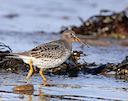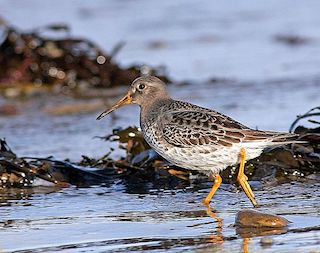 Scan the rocks near Lizard Point in the winter months, and you may be lucky enough to find a flock of hard-to-see Purple Sandpipers.
Scan the rocks near Lizard Point in the winter months, and you may be lucky enough to find a flock of hard-to-see Purple Sandpipers.
Photo: By Myosotis Scorpioides at en.wikipedia, CC BY-SA 3.0
Scientific name: Calidris maritima
Conservation status: IUCN Red List, Least Concern; UK Birds of Conservation Concern, Amber.
What to look for:
- Family: Scolopacidae (Sandpipers and Allies)
- Colouring and appearance: In winter, upper parts dark grey with purplish tinge, paler below. Summer plumage shows rusty red edges to feathers. Orange-yellow legs and down-curved beak that is yellow at its base. Thin white wing-stripe is shown when in flight. Juveniles are similar to an adult in winter plumage.
- Size: 44 cm length, 21 cm wingspan.
- Where: Rocky coastlines in winter, mainly in Orkney, Shetland, eastern Scotland, northern England as far south as Yorkshire, west coast of Ireland, and Devon and Cornwall.
- Call: Generally quiet, but may make a kwit call
- Similar species: Dunlin, which is smaller with dark legs.
 You’d think a bird with orange legs would be easy to spot. The Purple Sandpiper is, however, highly elusive, managing to blend into the background very effectively. It overwinters along stretches of rocky shoreline round the UK, foraging at the breaking point of the waves in flocks as it searches for its food of shellfish, invertebrates and plants. It is easiest to spot it from the movement as it jumps or takes small flights to avoid waves.
You’d think a bird with orange legs would be easy to spot. The Purple Sandpiper is, however, highly elusive, managing to blend into the background very effectively. It overwinters along stretches of rocky shoreline round the UK, foraging at the breaking point of the waves in flocks as it searches for its food of shellfish, invertebrates and plants. It is easiest to spot it from the movement as it jumps or takes small flights to avoid waves.
This medium-sized stocky wader is a winter visitor to the UK (about 13,000 birds; another 3,000 overwinter in Ireland). Birds begin to arrive from September, with the juveniles reaching our shores first. The adults follow after they have completed their moult into winter plumage. Its breeding range is much further north, in the Arctic tundra of Canada, Greenland and Europe. A ground-nester, the female chooses one of several scrapes created by the male using moss and lichen, and lays up to four eggs. The male does most of the incubating, and also tends the chicks.
The Purple Sandpiper has an Amber status in the UK due to recent declines in the overwintering population and the very small breeding population.
Did you know…?
…A very small number of pairs breed in Scotland, but the location is kept secret to protect them from being disturbed.
…Female Purple Sandpipers are a little larger than the males, and with a slightly longer bill.
More information and references:
Svensson, L., Mullarney, K., Zetterstrom, D.,1986. Collins Bird Guide, second edition (translated by Christie, D., Svensson, L.). HarperCollins, London.
Published: December 2014
Author: Amanda Scott
Photo: By Myosotis Scorpioides at en.wikipedia, CC BY-SA 3.0
